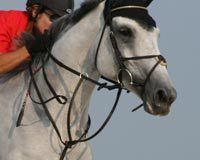
If you’ve ever found yourself approaching a fence with apprehension, or perhaps have had a bad fall or negative experience while jumping, you’re not alone in your jumping fears.
Tony Font, a hunter/jumper trainer in the Houston, Texas, area, has been training riders and horses for over 30 years. He trains out of his Timber Ridge Farm and is also a traveling clinician who has seen his fair share of apprehensive riders. He has a few tried and true techniques to help nervous riders overcome their fear of jumping.
Horse-Rider Match
Font says good horses make good riders. In the sport of jumping, Font believes it’s 65 percent horse, 25 percent rider and 10 percent luck.
“It’s really important to have a horse that knows more than the rider when the rider is green,” he says.
Properly matching horse and rider is critically important. If Font works with a horse and rider team that seems out of sync, often he suggests riding a different horse that can bring another set of skills and strengths to the equation.
There’s a lot of value to riding different horses. Just because you and your horse are disagreeing doesn’t mean the two of you are a bad match. However, if you and your horse are at a crossroads, see if there is a mount available to help you sort out the issue.
For example, if you’re having difficulty seeing a distance, Font suggests riding a horse that will choose his own takeoff spot and allow you to feel the difference.
“If a rider is green, the horse needs to be more trained,” says Font. “If a horse is green, he doesn’t have the foundation and knowledge to compensate for a rider’s mistakes very often.”
Riding another horse can give you the skills you need to overcome battles with your horse. It can be very valuable to have a basis for comparison.
“If you’ve only ever done something one way, it’s very hard to understand when an instructor tells you it wasn’t right,” says Font. When you sit on different horses, you can recognize differences in canter strides and gaits. You can compare rhythms between horses.
“If you have nothing to compare to, you’re sort of in the dark.”
Rebuilding Confidence
With riders who are struggling with jumping confidence, Font focuses on flatwork.
“You usually jump out of a gallop or canter, so I teach riders to feel the rhythm on their individual horse,” Font explains.
Based on the idea that most courses are built on a 12- to 13-foot stride, start on a 12-foot stride with a line of poles or small cross-rails. As you canter through them, focus on your rhythm. Pick a number of strides and practice counting.

A good, experienced horse can jump from different spots—short, medium and long—giving the rider more room for error.
If the horse is green, it can be much harder for the anxious rider to overcome jumping concerns, as the horse will have less ability to handle the confusion of a bad rider decision.
Keeping Rhythm on Course
To learn rhythm, practice jumping a course with poles or cavalletti.
“You can’t jump a horse every day,” Font cautions. “But for a green or less confident rider who needs a lot of practice, you want to let them practice as much as possible.”
By practicing on poles and cavalletti, you can minimize the physical and mental stress on the horse. “It’s a great way of achieving what you’re after without burning the horse out or making him sore.”
Practice Short Lines
If you’re practicing distance, start with short lines, such as three-, four- or five-stride lines. Font cautions against riding lines longer than five strides when starting out.
When you start to feel depth perception kick in, if you can see a distance, you’re making progress. For example, you might realize, “I’m on four and far away, so I need to add more leg to get there.” With practice, you’ll start to ride a better rhythm.
Through repetition, things will start to become second nature and you’ll start to use correct aids. Muscle memory will become your ally. You’ll hold the horse together over the jump, and even if the horse jumps too forward, you’ll be prepared to collect the horse.
When it comes to controlling the rhythm of your jumping round, it all goes back to understanding flatwork. Font compares the need to understand flatwork to driving down a dark road. “If you don’t know the road when you’re driving, you slow down to get a feel for what you’re doing. Use your common sense to find your way when jumping.”
ALLISON GRIEST is a freelance writer based in Texas.
This article originally appeared in the March 2015 issue of Horse Illustrated magazine. Click here to subscribe!






